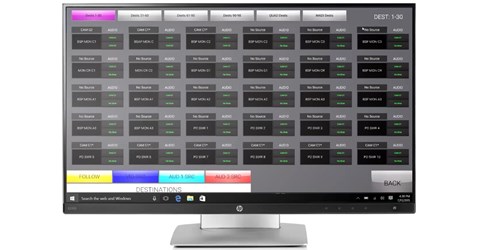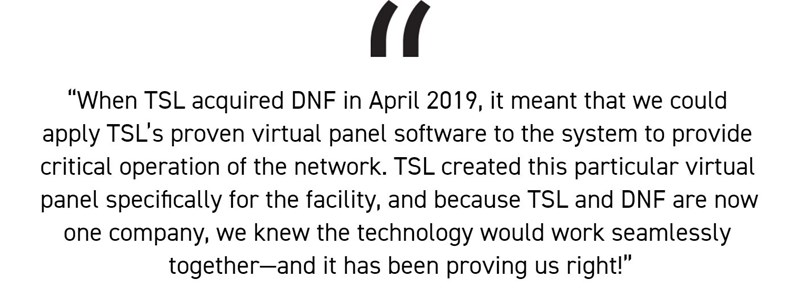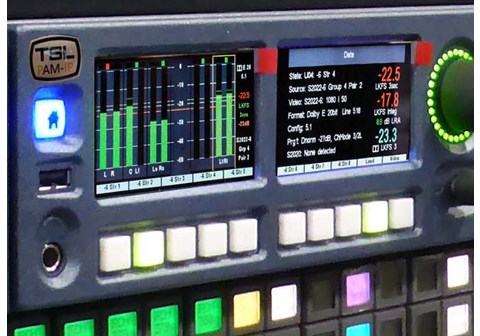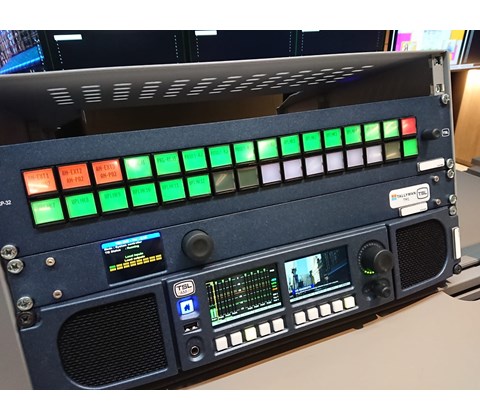EXPLORE THE HUB: Hot Topcis and Deep Dives | Ebooks and Technical Application | Case Studies
Access deep dive content on the IP transition and
much more with our dedicated Showcase.
Cost-Effective IP Routing Control Layer for Power Station at BerkleeNYC
As the industry continues to transition towards IP-based solutions, many integrators have found themselves limited by budget-related restrictions.
Diversified, a global technology solutions provider, recently ran into this challenge when it came to a project at BerkleeNYC, a campus-based recording studio formerly known as Avatar Studios. In the process of building a cost-effective IP network for the school’s renowned Power Station recording studio, Diversified turned to TSL Products to provide an IP routing interface that marries TSL’s virtual control processor, the GTP-V1, and its renowned Virtual Panels into a solution that TSL has coined, ‘IP-Cross Connect.’
Find out how this was done with this 5 minute demo by TSL Product Manager, Tom Pollard.
Clem Phillips, senior project engineer for Diversified, came up with a budget-friendly IP network design that utilizes COTS hardware and approached DNF Controls (now part of TSL Products), to create a specialized control software and flexible matrix environment so that any of BerkleeNYC’s four recording studios can operate separately or share audio and video resources on larger projects. Thanks to Diversified’s custom design, Power Station at BerkleeNYC’s IP network supports three floors of audio studios with nearly two dozen 4K-ready PTZ cameras as well a basement live-performance space. Phillips explained that the key element to the entire network is a software control layer provided by the TSL IP-Cross Connect solution. This ensures that all the individual pieces of audio and video gear can easily be found, launched and managed across the network. “TSL helped us put together a custom control layer for the entire facility to control the gateways using an NMOS IS-04 registry hosted within the virtualised servers alongside the GTP-V1 control processor,” he said.
The work of integrating the NMOS registry builds on TSL’s involvement with the AMWA IP showcase at IBC 2019 and at Broadcast Asia in 2018, where TSL demonstrated its virtual panels working with the DNF GTP-30 controlling Embrionix SFPs. As the transition to IP gains pace, and the industry looks beyond tier one and greenfield site IP projects, it is important that customers have the options to choose open, cost-effective solutions that allow them to leverage the benefits of IP without having to commit to the costs associated to a full infrastructure overhaul.
“It’s easy to be swept up in the ‘top tier’ view of virtualisation, IP and remote production and overlook the everyday practicalities and how virtualised solutions could easily be added and integrated within existing media workflows,” explained Mark Davies, Director of Product and Technology at TSL. “In the grand scheme of upgrading, rebuilding and expanding complex network facilities, the ‘glue’ devices that help disparate subsystems communicate and maintain a seamless workflow can be easily overlooked. In an ideal world, interoperability between various manufacturers’ equipment would be a given; in the real world, however, that’s rarely the case for several reasons.”
“With TSL’s solution, we can share resources between any of the studios with a simple button push,” said Philips. “Any of the studios can be used at any time and they can be combined for larger projects, and any of the control rooms can be used to capture video. With TSL’s software, the possibilities for Power Station are endless.” With TSL’s IP-Cross Connect solution, Power Station will be able to update its system with ease throughout the years. Diversified and TSL not only provided a cost-saving solution, but it also gave them the flexibility they required to support a wide variety of clients and students, both today and into the future.



IP Comes as Standard
The transition to IP technology may be the most talked about topic on the tech side of the television industry. But that does not mean it makes sense for all organizations. This three part series breaks down some of the key questions and issues faced as you consider the transition to IP.
IP is increasing the quality broadcasters can deliver exponentially. While, delivering 4K/UHD content within an IP infrastructure is practical, it can still be achieved in SDI environments.
On the horizon, however, is high dynamic range (HDR), high frame rate, and even 8K and VR.
Dive Deep into the practicalities, considerations, and solutions to consider when making the transition to IP.
Explore

Go Beyond Audio Monitoring With The PAM-IP
Audio monitoring has been a part of broadcast sound operations since the earliest days of television and radio. Today’s audio monitoring units have developed from being a basic meter with integrated loudspeaker to a fully networkable, controllable device with a variety of features and functions.
- The PAM-IP has now become the go-to audio monitor for customers deploying IP infrastructures, with more than 500 PAM-IP monitors deployed worldwide.
- The PAM-IP provides a high level of integration with third-party control systems, allowing ST-2110 multicast flow subscriptions to be managed using ‘In-Band’ or ‘Out of Band’ control protocols such as Ember+, NMOS IS-04/05 or TSL’s own RESTful API.
- Subscription status can be monitored remotely over a network with the PAM-IP webpage, along with health status information such as IP packet counters, signal format and PTP status.
- Supporting ST-2110, ST-2022-6 and Dante networks, as well as more traditional SDI, AES and Analogue sources, the PAM-IP provides premium audio monitoring wherever you may be on your transition IP.
- For the team at China Central Television, the key purchasing decision was based on TSL Products’ commitment to providing products capable of supporting IP delivery and emerging IP standards, such as AES-67, SMPTE 2022-6 and SMPTE 2110.
- CCTV has also worked with TSL Products for many years, with monitoring devices widely adopted in the master control and transmission systems at its headquarters in Beijing.






